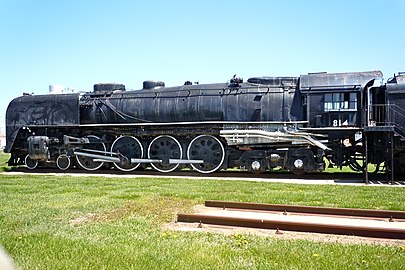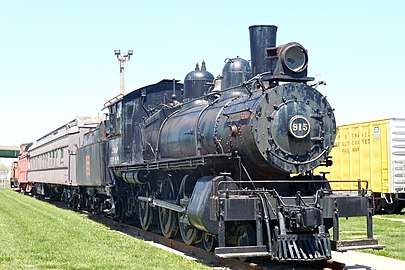
The original Chicago, Rock Island and Pacific Railroad was an American Class I railroad. It was also known as the Rock Island Line, or, in its final years, The Rock.

The California Zephyr was a passenger train that ran between Chicago, Illinois, and Oakland, California, via Omaha, Denver, Salt Lake City, Winnemucca, Oroville and Pleasanton in the United States. It was operated by the Chicago, Burlington & Quincy (CB&Q), Denver & Rio Grande Western (D&RGW) and Western Pacific (WP) railroads, all of which dubbed it "the most talked about train in America" on March 19, 1949, with the first departure the following day. The train was scheduled to pass through the most spectacular scenery on its route in the daylight. The original train ceased operation in 1970, though the D&RGW continued to operate its own passenger service, the Rio Grande Zephyr, between Salt Lake City and Denver, using the original equipment until 1983. In 1983 a second iteration of the California Zephyr, an Amtrak service, was formed. The current version of the California Zephyr operates partially over the route of the original Zephyr and partially over the route of its former rival, the City of San Francisco.

The Chicago, Burlington and Quincy Railroad was a railroad that operated in the Midwestern United States. Commonly referred to as the Burlington Route, the Burlington, or as the Q, it operated extensive trackage in the states of Colorado, Illinois, Iowa, Missouri, Nebraska, Wisconsin, Wyoming, and also in Texas through subsidiaries Colorado and Southern Railway, Fort Worth and Denver Railway, and Burlington-Rock Island Railroad. Its primary connections included Chicago, Minneapolis–Saint Paul, St. Louis, Kansas City, and Denver. Because of this extensive trackage in the midwest and mountain states, the railroad used the advertising slogans "Everywhere West", "Way of the Zephyrs", and "The Way West".

Saint Paul Union Depot is a historic railroad station and intermodal transit hub in the Lowertown neighborhood of Saint Paul, Minnesota. It serves light rail, intercity rail, intercity bus, and local bus services.
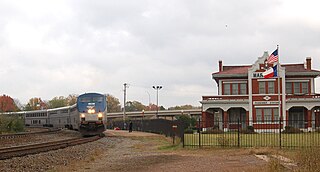
Marshall station is a railroad station in Marshall, Texas. It is served by Amtrak, the national railroad passenger system, which operates the Texas Eagle through Marshall each day, with service north to Chicago and west-southwest to Dallas, San Antonio and Los Angeles. The station also houses the Texas and Pacific Railway Depot & Museum.

Burlington station is an Amtrak train station in Burlington, Iowa, United States. It is served by the California Zephyr, with one daily train in each direction. The station was built by the Chicago, Burlington and Quincy Railroad (CB&Q) in 1944, replacing the previous union station used by the CB&Q and the Chicago, Rock Island and Pacific Railroad. That station burned in January 1943.
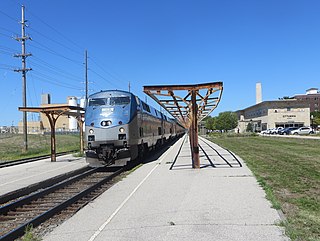
Ottumwa station is an Amtrak intercity train station in Ottumwa, Iowa, United States. The station was originally built by the Chicago, Burlington and Quincy Railroad, and has been listed as Burlington Depot by the National Register of Historic Places since November 26, 2008. It became a contributing property in the Historic Railroad District in 2011.

The Minneapolis Great Northern Depot, also known as Great Northern Station, was a passenger railroad station which served Minneapolis, Minnesota, USA. It was built in 1913 and demolished in 1978. It was located on Hennepin Avenue next to the Hennepin Avenue Bridge and across the street from the main Minneapolis Post Office.

The Atchison, Topeka and Santa Fe Passenger and Freight Complex is a nationally recognized historic district located in Fort Madison, Iowa, United States. It was listed on the National Register of Historic Places in 1992. At the time of its nomination it contained three resources, all of which are contributing buildings. The buildings were constructed over a 24-year time period, and reflect the styles that were popular when they were built. The facility currently houses a local history museum, and after renovations a portion of it was converted back to a passenger train depot for Amtrak, which opened on December 15, 2021.

Pueblo Union Depot is the historic railroad station in Pueblo, Colorado. It was built in the Richardsonian Romanesque style in 1889–1890 and added to the National Register of Historic Places in 1975. It is located within the Union Avenue Historic Commercial District.

The Chicago, Rock Island and Pacific Railroad Passenger Station is a historic building located in Iowa City, Iowa, United States. Built in 1898 for passenger use, it was the second depot in the city. The first one was built by the Mississippi and Missouri Railroad, a predecessor of the Chicago, Rock Island and Pacific Railroad (CRI&P), in 1855. This one was built through the efforts of Harry Breene, the local Rock Island agent. W.K. McFarlin, CRI&P's superintendent of maintenance and construction oversaw the building's construction. Architecturally, it is a combination of the Richardsonian Romanesque and Victorian Romanesque. The depot was built to similar designs of stations in Ottawa, Illinois, and Council Bluffs, Iowa.

The Boise Depot is a former train station in the western United States, located in Boise, Idaho. Opened 99 years ago in 1925, it is listed on the National Register of Historic Places (NRHP). At an elevation of 2,753 feet (839 m) above sea level on the rim of the first bench, the depot overlooks Capitol Boulevard and the Idaho State Capitol, one mile (1.6 km) to the northeast.

The Burlington, Cedar Rapids and Northern Railway (BCR&N) was a railroad that operated in the United States from 1876 to 1903. It was formed to take over the operations of the bankrupt Burlington, Cedar Rapids and Minnesota Railway, which was, in turn, the result of merging several predecessor lines, the construction of which began in 1869. The corporate headquarters were in Cedar Rapids, Iowa, and it had operations in Iowa and in Minnesota. It was succeeded by the Chicago, Rock Island and Pacific Railway.

The Hood River station is a historic train station in Hood River, Oregon, currently serving the heritage Mount Hood Railroad. The station was listed on the National Register of Historic Places in 1988 as the Oregon–Washington Railroad and Navigation Company Passenger Station. The station was built by the Oregon–Washington Railroad and Navigation Company, a subsidiary of the Union Pacific Railroad, in 1911. Amtrak's Pioneer also used the station and nearby area from 1977 to 1997.

Gulf, Colorado and Santa Fe Railroad Passenger Station is a former passenger train station in Fort Worth, Texas. From 1971 to 2002, it was used as Fort Worth's Amtrak station.
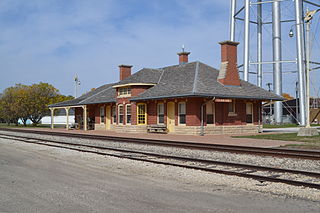
Burlington, Cedar Rapids and Northern Railroad Passenger Station, also known as Rock Island Railroad Depot and the Rock Island Depot Railroad Museum, is a historic building located in Clarion, Iowa, United States. The station was built in 1898 by contractor A. H. Connor & Company of Cedar Rapids, Iowa for the Burlington, Cedar Rapids and Northern Railroad (BCR&N). Clarion also had a Chicago Great Western Railway depot, no longer extant. At one time there were 14 trains that served the city. In 1903 the Chicago, Rock Island and Pacific Railway acquired the BCR&N, and this depot served that railroad. The single story, Romanesque Revival, brick structure measures 26 by 88.5 feet. It was added to the National Register of Historic Places in 1988.

The Burlington, Cedar Rapids & Northern Freight House, also known as the Rock Island Freight House, is a historic building located in Burlington, Iowa, United States. It was listed on the National Register of Historic Places in 1983.

Keokuk Union Depot is a historic train station on the west bank of the Mississippi River near downtown Keokuk, Iowa, United States. It was built from 1890 to 1891, and it was listed on the National Register of Historic Places in 2013.
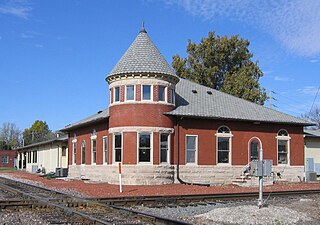
Union Depot, also known as the Grinnell Union Depot, is an historic building located in Grinnell, Iowa, United States. The Chicago, Rock Island & Pacific Railroad built the first tracks through the area in 1863, and they built a simple frame depot the same year. The Central Railroad of Iowa extended its north–south line to Grinnell nine years later, and their tracks crossed the Rock Island tracks at this location. The Minneapolis and St. Louis Railway eventually acquired the Central Railroad. The old depot became too small and this one replaced it in 1893. It was designed by the Rock Island Lines and built by a local contractor. The one-story, brick structure follows a square plan with a round corner tower at the junction of the two tracks. The tower provided the station agent with a clear view in all directions.

The Chicago, Rock Island and Pacific Passenger Depot-Pella, also known as the Pella Depot and the Rolscreen Museum, is a historic building located in Pella, Iowa, United States. The Des Moines Valley Railroad built the first tracks through the area in 1865, and they built a simple frame depot to serve passenger's needs. For 10 years, Pella served as the only rail stop in Marion County until a competing station was built in Knoxville, Iowa by the Chicago, Burlington, and Quincy Railroad. The Chicago, Rock Island & Pacific Railroad leased the Des Moines Valley's tracks beginning in 1878 and provided freight service through 1980. The old frame building was replaced, in 1906, with a single story, brick depot–a conventional building style for the railroad. The new, brick depot served as a passenger station until the latter 1940s. The last passenger service was as a stop on a short line motor train service between Eldon in southeast Iowa and Des Moines. The station was freight only by 1949.




